Garage Door Monitor and Opener
Dependencies: X_NUCLEO_COMMON ST_INTERFACES
Introduction
This system implements a simple garage door opener and environmental monitor. The hardware connects to the internet using Wi-Fi then on to the Pelion Device Management Platform which provides device monitoring and secure firmware updates over the air (FOTA). Pelion Device Management provides a flexible set of REST APIs which we will use to communicate to a web application running on an EC-2 instance in AWS. The web application will serve a web page where we can monitor and control our garage..
This project is intended to work on the DISCO-L475VG-IOT01A from ST Microelectronics It implements a simple actuator to drive a relay to simulate pushing the "open" button on older style garage doors which do not use a rolling code interface.
The system is designed to be mounted over the door so that the on board time of flight sensor can be used to detect if the door is open or closed.
The system also monitors temperature, humidity and barometric pressure.
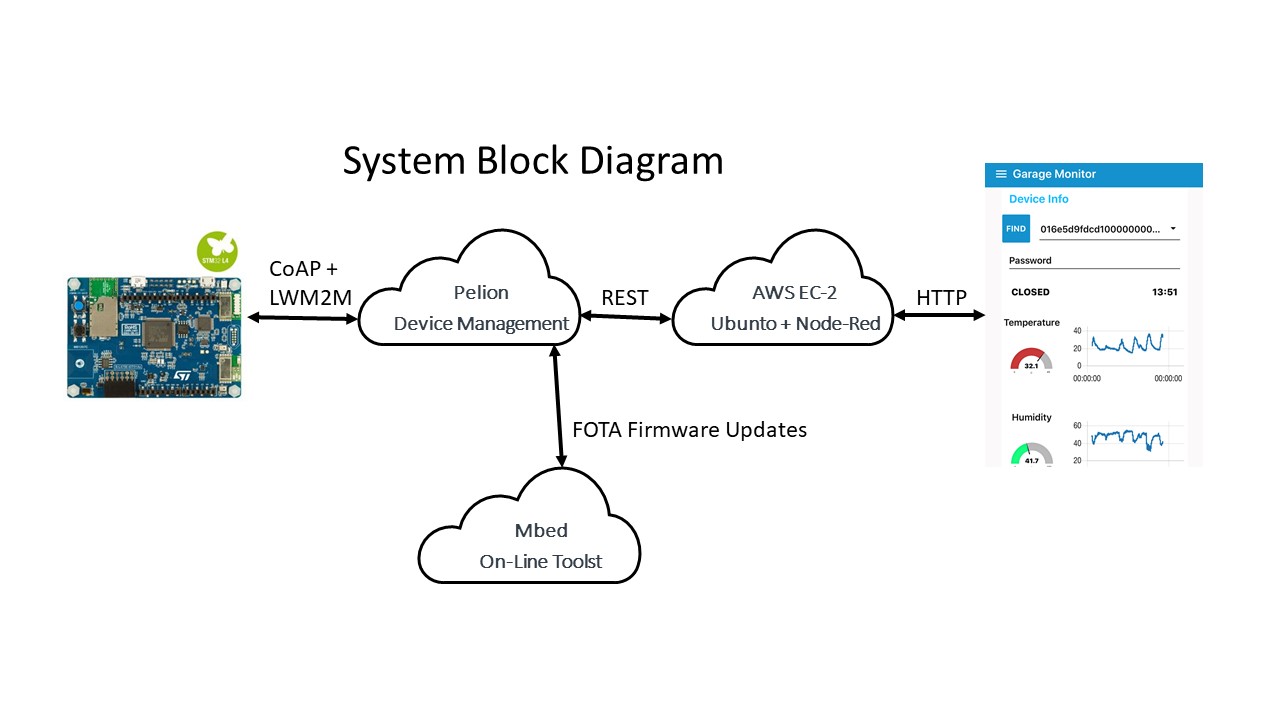
Hardware Requirements:
DISCO-L475G-IOT01A https://os.mbed.com/platforms/ST-Discovery-L475E-IOT01A/
Seeed Studio Grove Relay module https://www.seeedstudio.com/Grove-Relay.html
Seeed Studio Grove cable, I used this one: https://www.seeedstudio.com/Grove-4-pin-Male-Jumper-to-Grove-4-pin-Conversion-Cable-5-PCs-per-Pack.html
Connect to the PMOD connector like this:

This shows how I installed so that the time of flight sensor can detect when the door is open
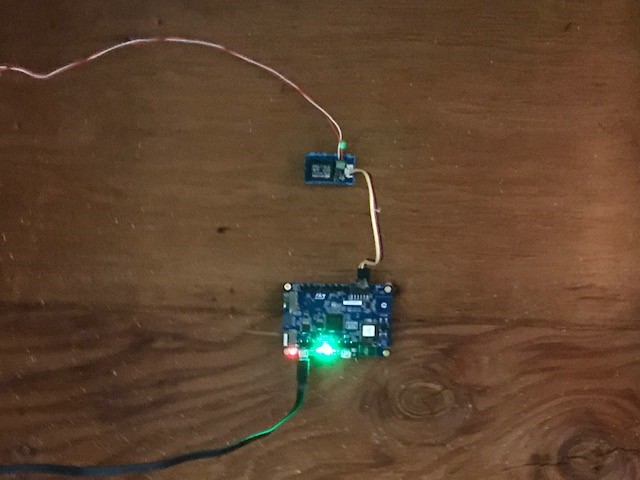
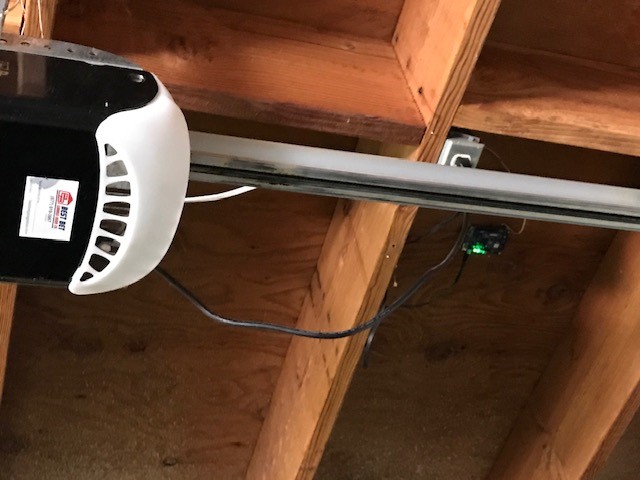
To use the project:
You will also need a Pelion developers account.
I suggest you first use the Pelion quick state to become familiar with Pelion Device Management. https://os.mbed.com/guides/connect-device-to-pelion/1/?board=ST-Discovery-L475E-IOT01A
Web Interface
For my web interface I am running node-red under Ubuntu in an EC2 instance on AWS. This can run for 12 month within the constraints of their free tier. Here is a tutorial: https://nodered.org/docs/getting-started/aws
You will also need to install several node-red add ons:
sudo npm install -g node-red-dashboard
sudo npm install -g node-red-contrib-mbed-cloud
sudo npm istall -g node-red-contrib-moment
After starting node-red import the contents of GarageFlow.txt from the project, pin the flow into the page.
To enable your web app to access your Pelion account you need an API key.
First you will neet to use your Pelion account to create an API key.
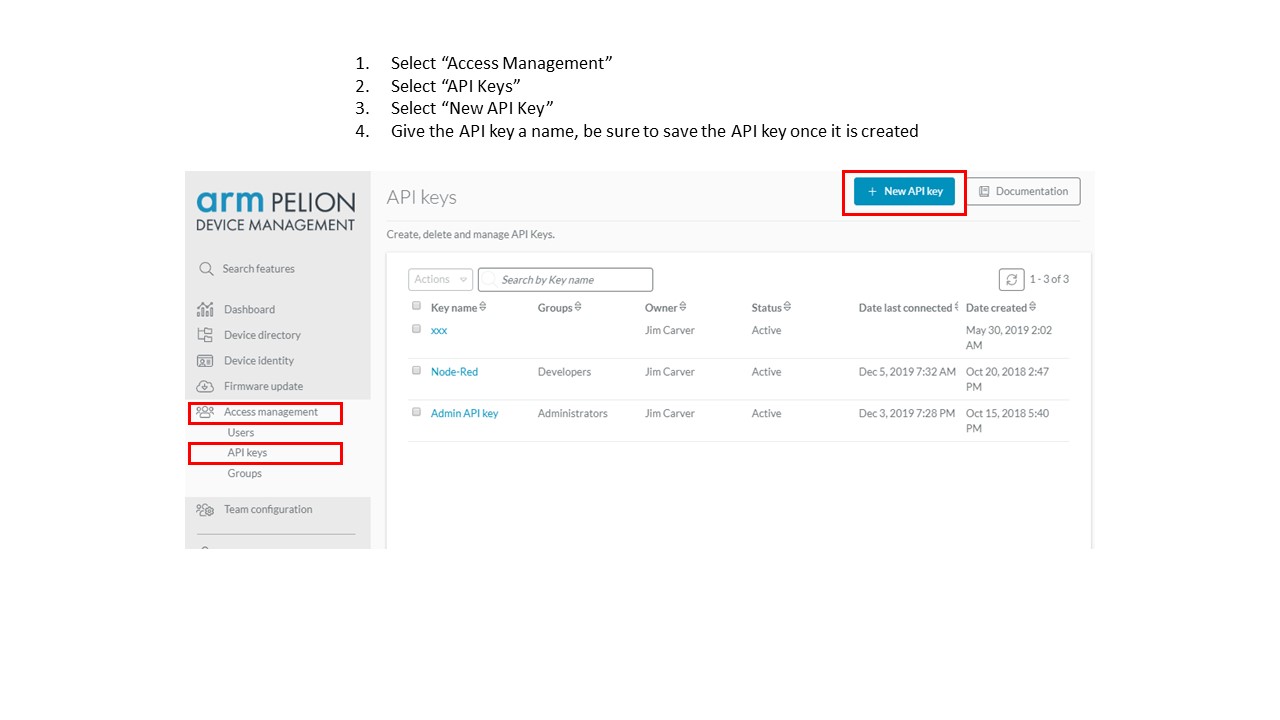
Now we need to apply that API key to your Node-Red flow.
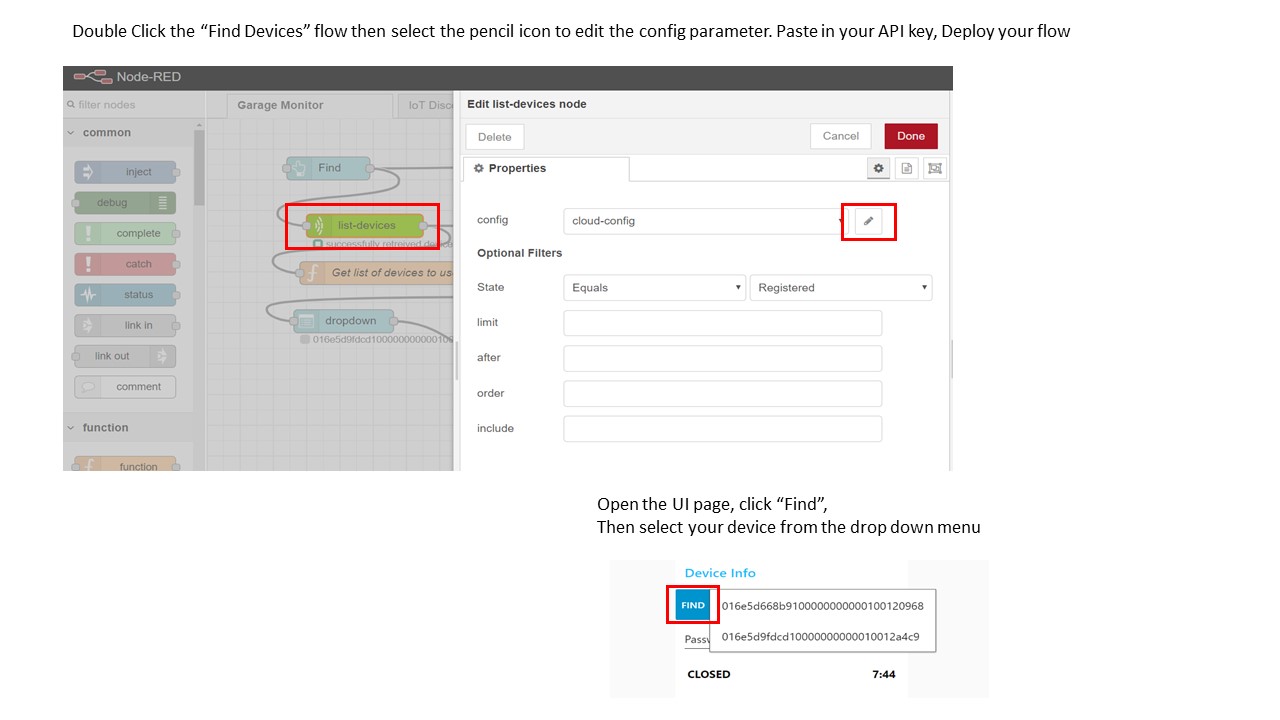
Diff: main.cpp
- Revision:
- 9:265744785d33
- Parent:
- 6:e0e1e1b93099
- Child:
- 10:b27c962b3c3f
--- a/main.cpp Sun Oct 14 17:15:45 2018 +0000
+++ b/main.cpp Sun Oct 14 19:01:53 2018 +0100
@@ -15,26 +15,23 @@
// See the License for the specific language governing permissions and
// limitations under the License.
// ----------------------------------------------------------------------------
-
+#ifndef MBED_TEST_MODE
#include "mbed.h"
#include "simple-mbed-cloud-client.h"
-#include "SDBlockDevice.h"
#include "FATFileSystem.h"
-#include "ISM43362Interface.h"
// An event queue is a very useful structure to debounce information between contexts (e.g. ISR and normal threads)
// This is great because things such as network operations are illegal in ISR, so updating a resource in a button's fall() function is not allowed
EventQueue eventQueue;
-// Declaring net interface as a global variable instead of local to avoid stack overflow
-ISM43362Interface net;
+// Default network interface object
+NetworkInterface *net;
-// Storage implementation definition, currently using SDBlockDevice (SPI flash, DataFlash, and internal flash are also available)
-SDBlockDevice sd(SPI_MOSI, SPI_MISO, SPI_SCK, SPI_CS);
-FATFileSystem fs("sd", &sd);
+// Default block device
+BlockDevice* bd = BlockDevice::get_default_instance();
+FATFileSystem fs("sd", bd);
-
-// Declaring pointers for access to Mbed Cloud Client resources outside of main()
+// Declaring pointers for access to Pelion Client resources outside of main()
MbedCloudClientResource *button_res;
MbedCloudClientResource *pattern_res;
@@ -100,28 +97,30 @@
* @param endpoint Information about the registered endpoint such as the name (so you can find it back in portal)
*/
void registered(const ConnectorClientEndpointInfo *endpoint) {
- printf("Connected to Mbed Cloud. Endpoint Name: %s\n", endpoint->internal_endpoint_name.c_str());
+ printf("Connected to Pelion Device Management. Endpoint Name: %s\n", endpoint->internal_endpoint_name.c_str());
}
int main(void) {
- printf("Starting Simple Mbed Cloud Client example\n");
+ printf("Starting Simple Pelion Device Management Client example\n");
printf("Connecting to the network using Wifi...\n");
// Connect to the internet (DHCP is expected to be on)
- nsapi_error_t status = net.connect(MBED_CONF_APP_WIFI_SSID, MBED_CONF_APP_WIFI_PASSWORD, (strlen(MBED_CONF_APP_WIFI_PASSWORD) > 1) ? NSAPI_SECURITY_WPA_WPA2 : NSAPI_SECURITY_NONE);
+ net = NetworkInterface::get_default_instance();
- if (status != 0) {
+ nsapi_error_t status = net->connect();
+
+ if (status != NSAPI_ERROR_OK) {
printf("Connecting to the network failed %d!\n", status);
return -1;
}
- printf("Connected to the network successfully. IP address: %s\n", net.get_ip_address());
+ printf("Connected to the network successfully. IP address: %s\n", net->get_ip_address());
- // SimpleMbedCloudClient handles registering over LwM2M to Mbed Cloud
- SimpleMbedCloudClient client(&net, &sd, &fs);
+ // SimpleMbedCloudClient handles registering over LwM2M to Pelion DM
+ SimpleMbedCloudClient client(net, bd, &fs);
int client_status = client.init();
if (client_status != 0) {
- printf("Initializing Mbed Cloud Client failed (%d)\n", client_status);
+ printf("Pelion Client initialization failed (%d)\n", client_status);
return -1;
}
@@ -141,12 +140,12 @@
blink_res->methods(M2MMethod::POST);
blink_res->attach_post_callback(blink_callback);
- printf("Initialized Mbed Cloud Client. Registering...\n");
+ printf("Initialized Pelion Client. Registering...\n");
// Callback that fires when registering is complete
client.on_registered(®istered);
- // Register with Mbed Cloud
+ // Register with Pelion DM
client.register_and_connect();
// Placeholder for callback to update local resource when GET comes.
@@ -157,3 +156,4 @@
// You can easily run the eventQueue in a separate thread if required
eventQueue.dispatch_forever();
}
+#endif